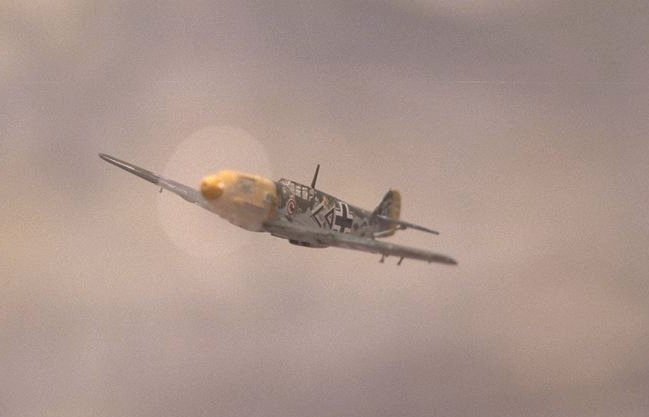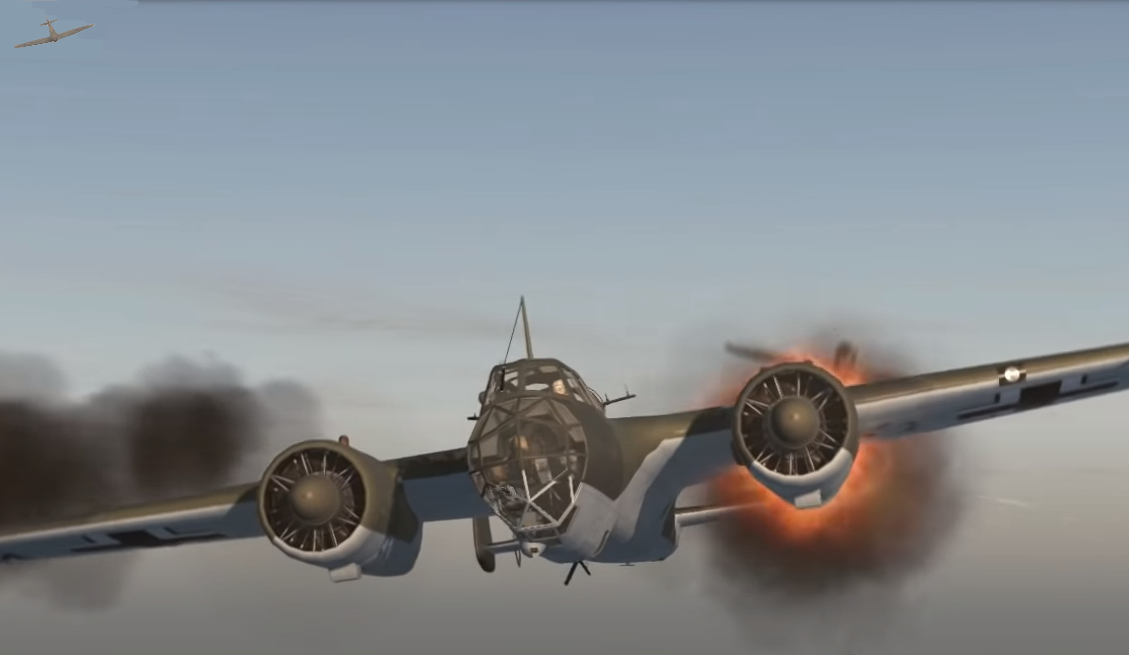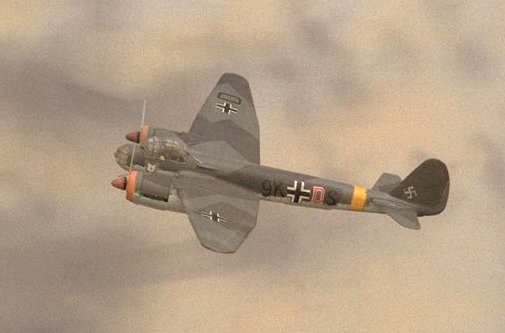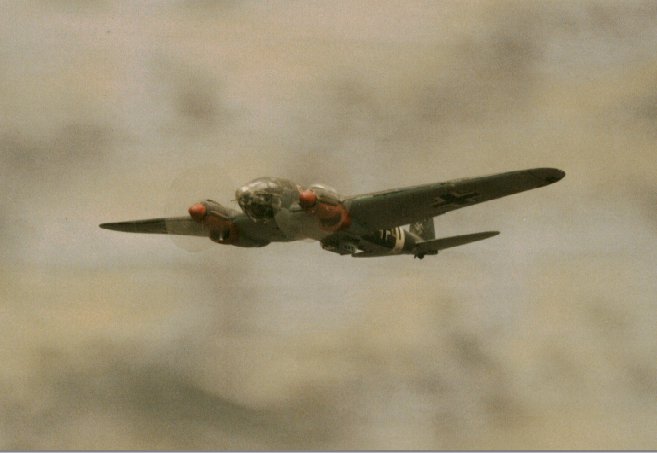Royal Air Force |
Hawker Hurricane I
This was the first RAF fighter to reach speeds greater than 300mph and came into service with 111 Sqn at Northolt in late 1937.
Designed by Sydney Camm, the Hurricane was based on the Hawker Fury biplane. This allowed many of the existing jigs to be useed in manufacture thus permitting a faster and cheaper production process. A total of 29 fighter squadrons were equipped
with Hurricanes by July 1940. While slower than the Spitfire and with an inferior rate of climb, the Hurricane proved to be more rugged and a stable gun-platform. Hurricanes
accounted for more Luftwaffe aircraft losses than all other air defences combined
including anti-aircraft fire. However, the Hurricane in 1940 was at the peak of its development and later modificatiions detracted from its overall performance as a fighter. Whereas the Spitfire's performance increased with each modification.
| |
Hurricane
I |
 |
Wingspan
|
40ft
0in
|
Length
|
32ft 4in
|
Laden Weight
|
8,100lb |
Engine
|
RR
Merlin III 1,030hp |
Ceiling
|
34,2000ft
|
Range
|
460
miles
|
Rate of Climb
|
3,150
fpm
|
Max. Speed
|
328mph |
Armament
|
8X
.303 Brownings |
Crew |
1 |
|
| |
Supermmarine Spitfire I
Designed by R J Mitchell, the Spitfire entered service in the RAF in August 1938 with 19 Sqn at Duxford. Early MkIs had a two-bladed fixed-pitch airscrew which was soon replaced with a three-bladed two-speed version. By August 1940 most MkIs had been fitted with constant speed airscres which considerably enhanced performance. Early attempts to modify the armament from 8, .303 Brownings to 4, Browning and 2, 20mm cannon met with failure. However, the speed, handling and rate of climb was superior to the Hurricane although it could absorb far less battle dame. During the battle 19 squadrons were equipped with Spitfires. The basic design of the Spitfire was such that throughout the war moifications to wings, powerplants and armament all improved its performance. |
| |
| |
Spitfire
I |
 |
Wingspan
|
36ft
10in
|
Length
|
29ft
11in
|
Laden Weight
|
6,785lb
|
Engine
|
RR Merlin II 1,440hp
|
Ceiling
|
31,900ft
|
Range
|
395
miles
|
Rate of Climb
|
3,125
fpm
|
Max. Speed
|
362
mph
|
Armament
|
8X
.303 Brownings
|
Crew |
1
|
|
| |
| |
| Boulton Paul Defiant turret fighter |
| Late in 1939 the Bolton Paul Defient entered RAF service with 264 Sqn at Martlesham Heath, one of only two fighter squadrons to be equipped with this aircraft. The powerful turret armament inflicted enormous damage to bombers but the lack of forward-firing guns and poor maneuvrability was soon discovered by Luftwaffe Messerschmitts who exploited this fatal weakness. Both 264 Sqn and 141 Sqn suffered terrible losses and the Defiant was withdrawn. On
19 July, 141 Sqn from West Malling was attacked by elements of JG51 flying
Bf109Es. Of the nine Defiants only two survived.The aircraft was redeployed as a night-fighter with four squadrens in late 1940 shooting down more enemy aircraft than any other type |
Wingspan
|
39ft
4in |
 |
Length
|
35ft
4in |
Laden Weight
|
8,600lb |
Engine
|
RR
Merlin XX 1,260hp |
Ceiling
|
31,800ft |
Range
|
480
miles |
Rate of Climb
|
1,900
fpm |
Max. Speed
|
315mph |
Armament
|
4X
.303 Brownings |
Crew |
2 |
| |
|
|
| |
| |
| Bristol Blenheim If |
| Entering RAF service in 1937 with 114Sqn, the first of seven squadrons to use this aircraft in the fighter configuration. At the time of it's introduction it was faster than contemporary fighters but by 1940 it was totally outmatched. The Blenheim as a fighter was not a success as it could not compete with fast single-engined fighters. The high casualty rate was not supportable and the type was withdrawn from daylight operations in July 1940. In 1941 the Blenheim IF reappeared as a night-fighter, some equipped with AI Mk III airborne interception radar. In this role they met with better success. |
Wingspan
|
56ft 4in |
 |
Length
|
39ft 9in |
Laden Weight
|
|
Engine
|
2X 840hp Bristol Mercury VIII |
Ceiling
|
27,280ft |
Range
|
1,125 miles |
Rate of Climb
|
|
Max. Speed
|
285mph |
Armament
|
6X .303 Brownings |
Crew |
3 |
|
| |
| |
| Gloster Gladiator II |
| Entering service with the RAF in 1937 with 72 Sqn, the Gladiator was a relic from the last generation of fighters. In Norway and the battle for France Gladiators put up an heroic resistance against far superior aircraft. Only 247 Sqn RAF and 804 Sqn, Fleet Air Arm flew Gladiators during the Battle of Britain. |
Wingspan
|
32ft
in |
 |
Length
|
27ft
5in |
Laden Weight
|
|
Engine
|
840hp Bristol Mercury VIII |
Ceiling
|
33,500ft |
Range
|
444
miles |
Rate of Climb
|
3,200
fpm |
Max. Speed
|
257mph |
Armament
|
4X
.303 Brownings
|
Crew |
1 |
|
| |
| |
| Bristol Beaufighter 1f |
| |
Wingspan
|
57ft 10in
|
|
Length
|
41ft 8in |
Laden Weight
|
21,600 |
Engine
|
2X 1,670hp Bristol Hercules VI Radials |
Ceiling
|
26,500ft |
Range
|
1,480miles |
Rate of Climb
|
|
Max. Speed
|
333mph |
Armament
|
4X 20mm cannon 6X 0.303 rcmg |
| Crew |
2 |
| |
|
|
| |
LUFTWAFFE |
| Messerschmitt Bf109E-4 |
| B and C models of the Bf109 saw action in Spain with Condor legion in 1936. Each succesive model had more a more powerful engine and armament. Luftflotten 2, 3 and 5 included 23 Gruppen of the Bf109E-3 and E-4, (approximately 950 aircraft). by August 1940. The aircraft had an altitude advantage over both the Spitfire and Hurricane and could dive faster, the fuel injected engine permitting inverted dives. However, the aircraft was relatively fragile and the narrow track undercarriage resulted in many accidents as did the high angle of the aircraft on the ground , limiting the pilot's field of view |
Wingspan
|
30ft
6½in |
 |
Length
|
29ft
7in |
Laden Weight
|
6,100lb |
Engine
|
DB601A
1,100hp |
Ceiling
|
36,090ft |
Range
|
680
miles |
Rate of Climb
|
3,200
fpm |
Max. Speed
|
354mph |
Armament
|
2X
7.92mm MG17
2X 20mm MG FF cannon |
Crew |
1 |
|
| |
| |
| Messerschmitt Bf110C-4 |
| The Bf110 Zerstörer (destroyer) was a long-range fighter that first saw action in Poland and later Norway. When unopposed it met with some success in the invasion of France but it was completely outmatched by modern fighters and the disastrous losses of aircraft and crew enforced their withdrawal by the end of 1940.Eight Gruppen were deployed in the Battle of Britain to screen the bomber force The C-4 variant was equipped with an FuG 10 radio as a navigation aid as well as improved electrical systems and armament. Later in the war modified versions of the Bf110G had considerable success when equipped as night fighters, some fitted with Lichtenstein SN-2 search radar and a 13mm MG pointing upwards and forwards from the rear of the cockpit to attack bombers in their blind-spot known as "Schrägemusik". |
Wingspan
|
53ft
4¼in |
 |
|
Length
|
341ft
7¼in |
Laden Weight
|
14,881lb |
Engine
|
2X1,100hp
DB605B-1 |
Ceiling
|
32,810ft |
Range
|
482
miles |
Rate of Climb
|
|
Max. Speed
|
349mph |
Armament
|
2X 20mm cannon
4X 7.92mm MG 17 1X 7.92mm MG81Z 1X 37mm cannon |
Crew |
2 |
|
| |
| |
| Dornier Do17Z |
| The Do17 first flew in 1934 but though fast had limited civilian use. Redesigned as a schnellbomber it entered service with the Luftwaffe in 1935. Reconnaisance versions were also developed. The aircraft performed impressively in Spain, though against against inferior aircraft of the same vintage. The Do17Z was the most produced model and entered service in 1939. Deployed with Luftflotten 2 and 3 the Dornier was used extensively in the Battle of Britain but was found to be extemely vulnerable to Spitfires and Hurricanes. Losses were high and by the end of 1942 the Dornier gave way to the more powerful Do217 and was been withdrawn from front-line service. |
Wingspan |
62ft
4 in |
|
Length |
58ft
4½in |
Max
Weight |
36,817lb |
Engines |
2X
1,550 BMW801MA |
Ceiling |
13,780ft |
Range |
1,335
miles |
Max.
Speed |
348mph |
Armament |
2X
13mm M131
1X15mm cannon
5X 7.92 MG15 |
Bombload |
4,409lb |
Crew |
5 |
|
| |
| |
| Junkers Ju88A-4 |
| As with the Dornier 17, the Ju88 was designed as a fast bomber entering service with the Luftwaffe in 1939. It made up eight Gruppen in Luftflotten 2, 3 and 5 in the bomber configuration and others in the reconnaisance role (Aufklärungsgruppen). While a fast and effective bomber the versatile Ju88 was also able to be deployed in a variety of roles from anti-shipping and mine laying to night fighter duties and remained in service throughout the war. |
| |
Wingspan |
65ft 7¾in |
|
Length |
47ft
2¾in |
Max
Weight |
30,864lb |
Engines |
2X
1,340hp JJ 211J-2 |
Ceiling |
26,900ft |
Range |
1,106
miles |
Max.
Speed |
292mph |
Armament |
4X
7.92mm MG81
2X 7.62mm MG81 |
Bombload |
6,614lb |
Crew |
4 |
|
| |
| |
| Heinkel He111H-3 |
| The He111 was originally designed as a passenger aircraft. In the bomber variant the He111 entered service with the Lufwaffe in 1935 and served with Kampfgruppe 88 in Spain. It proved to be highly effective, albeit against inferior fighter oppostion. However, during the batttle for France and later in the Battle of Britain it faced modern fighters for the first time and its firepower was found to be insufficient with consequent disastrous losses of aircraft and crew. |
Wingspan |
74ft
1¾in |
|
Length |
53ft
9¾in |
Max
Weight |
30,865lb |
Engines |
2X
1,100hpDB 601A |
Ceiling |
25,580ft |
Range |
1,212
miles |
Max.
Speed |
252mph |
Armament |
1X20mm
cannon;
1X13mm MG131;
4X7.9mm MG 81
2X7.9mm MG15 |
Bombload |
4,409lb |
Crew |
5 |
|
| |
| |
| Junkers Ju87B-2 |
| The name Stuka is derived from 'Sturzkampfflugzeug', a dive-bomber. Early models of this aircraft entered service with the Luftwaffe in 1936. Later serving in Spain the Stuka gave impressive results for accurate bombing. The 'B' variant was more powerful and better armed. Unopposed, the Stuka became the embodiment of Blitzkrieg and it was not until Dunkirk that the weakneses were probed and exploited. During the Battle of Britain the Stukageschwader suffered horribly against Spitfires and Hurricanes with devastating losses. Most were withdrawn by August 1940. |
| |
Wingspan |
49ft
2½in |
|
Length |
37ft
8in |
Max
Weight |
14,550lb |
Engines |
1X
900hp JJ 211-P |
Ceiling |
26,250ft |
Range |
410
miles |
Max.
Speed |
248mph |
Armament |
2X
20 MG151/20 cannon 2X 7.9mm MG 81 |
Bombload |
5,070lbs |
Crew |
2 |
|











